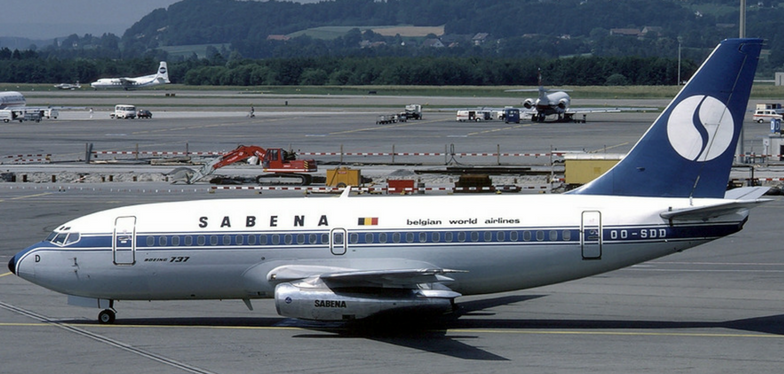Sabena, "You're in good hands!"

Sabena was one of the emblems of Belgian pride that was exported around the world. Founded in 1923, Sabena (Société Anonyme Belge d’Exploitation de la Navigation Aérienne) was the third oldest airline in the world, just behind KLM (Netherlands) and Avianca (Colombia) created in 1919. It started out at Haren airport (north-east of Brussels), then set out to conquer the world with the launch of a fleet of military aircraft converted into civilian carriers which flew around Europe (Brussels-London and Brussels-Paris) as well as the colony of Congo (opening of a line between Léopoldville and Stanleyville). At the start of the aviation adventure, these were small planes, built like matchboxes, so bumpy that more often than not, the passengers were sick. They were so noisy inside that passengers had to block their ears with cotton wool. The cabins were not airtight and there was no heating. It was freezing cold and when the planes landed on wet ground mud was splattered everywhere.
After a year and a half, Sabena got rid of its recycled post-war equipment and, after the purchase of Handley Page HP W8b twin engines for Europe, in 1925 it equipped itself with HP W8f trimotors and Havilland DH50s for the Congolese line. Technology progressed, slowly but surely. The new models had heating in the cabin via the exhaust system and improved soundproofing. The weight of the three engines required the company to reduce the number of passengers to ten. Georges Nelis, the founder of civil aviation in Belgium, justified this concession, and its commercial impact, on the importance of safety. For air transport, safety was the key to a company's success.
Thieffry, a flying ace from the First World War Belgian air force, was the first pilot to fly from Belgium to Congo in 1925, a journey that took 51 days, with 75 hours of actual flying time. This feat was possible thanks to the unconditional support of King Albert I, who guaranteed the cost of the Sabena plane from his own personal funds in the event of it being lost. Initially very much against this attempt, Sabena nevertheless managed to make the most of this feat by providing a highly skilled young pilot, Léopold Roger and an exceptional mechanic, Joseph (known as Jeff) De Bruycker. After the feat was accomplished, the Belgian airline company did everything to operate this line for purely commercial purposes, but had to wait until 1935 for the first commercial flights to start operating.
Before the Second World War, it extended its fleet with the addition of the famous DC-3 Dakota. However, it was not until the end of the war that its business started up again with a view to the development of a very wide-scale commercial air transport service. In addition to the generalised use of air hostesses, the company acquired DC-4, DC-6 and DC-7 aircraft, and entered the age of jet engines with the Boeing 707, followed by the Boeing 747 and the DC-10.
After 1946, the Belgian national company continued to widen its network over the four continents, with a special focus on African lines (Léopoldville-Kinshasa, Dakar, Entebbe, Douala, Kano, etc.) which became become its trademark and a major share of its market along with the Brussels-New York service. Asia continued to be the weak link in the network. Apart from Tokyo and India, the company did not develop a network on this continent.
However, despite its many activities, Sabena was never a truly profitable commercial enterprise. And this, regardless of the many efforts made to right Sabena's economic situation with budgetary cutbacks and restrictions in human resources. On 7 November 2001, SABENA, the second oldest European airline, went into liquidation.
But, the history of Belgian aviation did not end with this bankruptcy: despite fears and the takeover by the Eurowings group, Brussels Airlines looks set to survive and, above all, the new company, Air Belgium, is opening up new horizons from Charleroi...